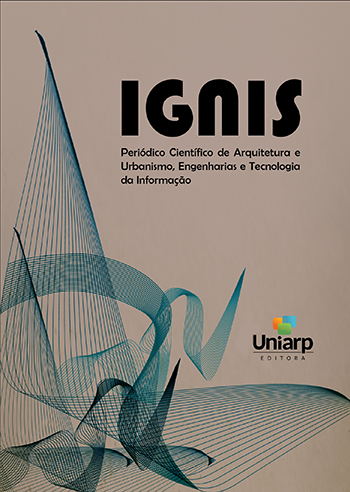RECOMENDAÇÕES TÉCNICAS À PREVENÇÃO DE FENÔMENOS PATOLÓGICOS EM PISOS DE CONCRETO ARMADO: AMBIENTE INDUSTRIAL TÊXTIL SOB AÇÃO DE SOLUÇÕES ÁCIDAS
Palavras-chave:
Concreto Armado, Patologia, Piso Industrial Tinturaria.Resumo
As estruturas de concreto armado estão presentes na construção brasileira em grande escala e cada vez mais os técnicos e responsáveis da área deparam-se com problemas e reparos relacionados a fatores ocasionados por solicitações intensas, ambientes agressivos, entre outros. No presente trabalho realizou-se um estudo da estrutura de um piso industrial de concreto armado de uma tinturaria de Brusque (SC), com o objetivo de identificar quais os agentes agressivos que atuam no processo de degradação do piso em concreto armado de uma indústria têxtil. A metodologia teve abordagem qualitativa e quantitativa; quanto aos procedimentos técnicos se caracterizou como bibliográfica aliada ao estudo de campo. Os resultados mostraram que mesmo com baixas taxas de porcentagem de áreas atingidas por ataque de soluções ácidas, os pisos industriais necessitam ser revestidos apropriadamente, a fim de evitar as manifestações patológicas oriundas de ambientes agressivos. Ainda mostraram que as patologias identificadas, foram principalmente, em áreas molhadas, ou seja, ao lado de cada máquina de tingimento no piso da tinturaria, ocasionada por ataques de corantes diluídos em água que formam soluções ácidas, uma vez que a máquina do processo de tingimento faz uso desses em suas composições para realizar o tingimento. Os ácidos são altamente agressivos às estruturas de concreto armado, principalmente, quando em contato direto com o concreto, pois desintegra a pasta de cimento e expõe os agregados, tornando-o com o passar do tempo ainda mais suscetível à degradação. Conclui-se que a lixiviação é responsável por degradar a capa do concreto pela infiltração de soluções ácidas e de água sobre os poros do concreto, reduzindo sua resistência mecânica.
Palavras-Chave: Concreto Armado. Patologia. Piso Industrial Tinturaria.
ABSTRACTReinforced concrete structures are present in Brazilian construction on a large scale and more and more technicians and managers in the area are faced with problems and repairs related to factors caused by intense requests, aggressive environments, among others. In the present work, a study of the structure of an industrial concrete floor of a Brusque dyeing plant was carried out in order to identify the aggressive agents that act in the process of degradation of the reinforced concrete floor of a textile industry. The methodology had a qualitative and quantitative approach; technical procedures was characterized as a bibliography allied to the field study. The results showed that even with low percentages of areas hit by acid solutions, industrial floors need to be properly coated in order to avoid pathological manifestations from aggressive environments. They also showed that the identified pathologies were mainly in wet areas, that is, next to each dyeing machine on the dyeing floor, caused by attacks of dyes diluted in water that form acidic solutions, since the process machine dyeing makes use of these in their compositions to accomplish the dyeing. Acids are highly aggressive to reinforced concrete structures, especially when in direct contact with the concrete, as it disintegrates the cement paste and exposes the aggregates, making it over time even more susceptible to degradation. It is concluded that the leaching is responsible for degrading the concrete cover by the infiltration of acidic solutions and water over the pores of the concrete, reducing its mechanical resistance.
Keywords: Armed Concrete. Pathology. Industrial Dyeing Floor.
Downloads
Publicado
Edição
Seção
Licença
Autores que publicam nesta revista concordam com os seguintes termos:- Autores mantém os direitos autorais e concedem à revista o direito de primeira publicação, com o trabalho simultaneamente licenciado sob a Licença Creative Commons Attribution que permite o compartilhamento do trabalho com reconhecimento da autoria e publicação inicial nesta revista.
- Autores têm autorização para assumir contratos adicionais separadamente, para distribuição não-exclusiva da versão do trabalho publicada nesta revista (ex.: publicar em repositório institucional ou como capítulo de livro), com reconhecimento de autoria e publicação inicial nesta revista.
- Autores têm permissão e são estimulados a publicar e distribuir seu trabalho online (ex.: em repositórios institucionais ou na sua página pessoal) a qualquer ponto antes ou durante o processo editorial, já que isso pode gerar alterações produtivas, bem como aumentar o impacto e a citação do trabalho publicado (Veja O Efeito do Acesso Livre).

